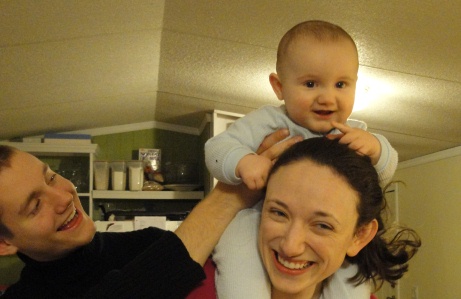Note: This article is part of the USCCB “Clean Heart” series and is a companion resource to the USCCB formal statement Create in Me a Clean Heart: A Pastoral Response to Pornography; a printed pamphlet version of this article and others may be purchased at the USCCB online store.
We live in a sexually broken culture. In modern times, the prevalence of pornography has become a pressing problem for parents. Here are five steps parents can take to raise chaste children in a pornographic world.
1. Parents, teach your children the true meaning of human sexuality and educate them in chastity.
Forming a child in chastity is one of the most important responsibilities mothers and fathers have.1 Because we live in a highly sexualized culture, children are receiving an education in sexuality all the time. It’s imperative that you as parents give them an education and formation in authentic love and chastity throughout their childhood.
First and foremost, parents must emphasize the beauty and sacredness of the body and sexuality, and the truth that we are made for lasting love. We are each made in God’s image and therefore called to love, for “God is love” (1 Jn 4:8). Far from the Church being down on sex, the Church wants to preserve the true meaning of love, including sexuality. Marital intercourse as God designed it serves to promote the oneness of husband and wife and the creation of new life (see Gen 1:28; 2:23-24). Parents should take every opportunity to impress on their children the goodness of God’s design for marriage and the family.
To all parents: Thank you for your great love and sacrifice! . . . You are the first guardians and teachers of your children and are called to be their models of chaste and fruitful love. —Create in Me a Clean Heart, p. 23
Parents should also stress for their children the power of sex. One analogy to use is that sexuality is like a fire. A fire in the fireplace is good; its blaze brings warmth, light and cheer to the home. A fire in the middle of the living room floor is bad; without proper boundaries, it can burn the whole house to the ground.
Take heart! Most parents who talk with their children about the truth and meaning of human sexuality and the harms of pornography find that the awkwardness of the conversation is on the side of the parent—not the child. Children are eager for direction and guidance in such an important area of their lives.
2. Be aware of the widespread availability of pornography and the fact that many children are exposed to it at young ages.
The average age of first exposure to pornography is eleven.2 Over a quarter of children see pornography before beginning puberty, a percentage that has increased over past generations.3 By the age of eighteen, over 90 percent of boys and 60 percent of girls will have accessed pornography online at least once.4 With each new generation now growing up with the Internet, being exposed to pornography is no longer the exception but the norm.
Some children are exposed to pornography inadvertently when online. Others are exposed because of natural curiosities about human sexuality. The younger children are, the more of an effect it can have on their young brains. Study after study shows that young people who seek out and consume online pornography are more likely to have “recreational” attitudes about sex.5 Moreover, researchers have also found there is a significant correlation between frequent porn use and feelings of loneliness and major depression.6
Children and teens who view pornography in effect receive an education about sexuality from what they are viewing. —Create in Me a Clean Heart, p. 17
Often parents fear that teaching their children about sexuality means saying “too much too soon.” But given the young ages at which children may first see pornography, unfortunately what happens more often is that parents say “too little, too late.” Mothers and fathers must use prudence and prayerfully consider how much information a particular child can handle and understand at a particular age. Good information arms children with the truth, enabling them to spot more easily the lies of our hyper-sexualized culture. Education in chastity can begin at young ages with encouraging modesty, respect for one’s body, and self-control. Later instruction, best given by the parent of the same sex as the child, can build on this foundation with delicate and clear guidance on sexual morality.
3. If you struggle with pornography use, seek your own healing to be a good example and witness of chaste love for your children.
Many parents find it difficult to broach subjects like sexuality or pornography with their children because of the shame they feel about their own sexual sins and struggles, whether past or present. But do not allow shame or embarrassment to stop you from teaching your children about chastity. If anything, parents who have struggled with sexual behaviors realize that for their children’s sake, they must be honest with themselves, repent of their sins, and seek out healing. A parent’s story of healing is a powerful story of redemption and conversion.
Parents, if you personally struggle or have struggled with pornography or other forms of sexual sin, it is never too late to set a good example for your children. Seek the help you need from the Church, professional counselors, or local support groups to overcome sinful habits that have weighed you down.7
4. Be vigilant about what technology you allow in your home, and establish clear boundaries by installing filtering software and educating your children about technology use.
Technology, and particularly the Internet, is now the primary gateway to accessing pornography. Everything from iPods to game consoles, from laptops to tablets, from TVs to smartphones—all devices that connect to the Internet can access pornography. It’s thus important that parents follow this rule: If I am not willing to monitor it, I will not provide it.
Parents and guardians, protect your home! —Create in Me a Clean Heart, p. 23
When it comes to protecting our children from the worst of the worst online, good parental controls can go a long way. Here are some tips:
- Install Internet filtering on all your family’s Internet-accessing devices: home computers, laptops, tablets, phones, etc. Good filtering software, when set up properly, can block nearly all inadvertent exposure to inappropriate material online.
- Establish a culture of accountability in your home. Along with filtering software, parents should also be receiving Internet accountability reports. Accountability is not about “catching” children doing wrong but about helping children think more critically about their Internet use. It also encourages parents to have conversations about sites their children visit and search terms they use.
- Use “safe search” on all web browsers. While these are not foolproof, they can provide another layer of protection.
- Many mobile devices today come with built-in parental controls that limit the kind of content and apps children can access on these devices. Make sure to use these.
Another concern parents need to be aware of is online sexual interactions. First is the increasingly widespread problem of “sexting”—sending sexually explicit messages, images, or videos through text messaging, e-mail, or social media. One study estimated that two-thirds of teens and young adults have received a “sext,” and forty percent have sent one.8 Some programs allow a user to send pictures that “fade away” right after they are sent, making it harder for parents to keep tabs on their children’s activity. Children and teens may feel pressured into sending or receiving a “sext” by peers.
The second threat are online sexual predators. While there are many different predation scenarios, most of them boil down to adults (mostly men) preying upon common teenage vulnerabilities. Online predators primarily use social media to identify and groom their victims.
The fact is that there will probably always be both adults and teen peers out there who seek to manipulate and misuse others for sexual pleasure and power. What parents must do is engender wisdom into their children so they aren’t easy targets. First, as emphasized above, speak with your children about the body and its sacredness. Teach them that we should keep certain parts of the body private, not because the body is bad or shameful, but because only your spouse should see you “naked and unashamed,” as Scripture says (Gen 2:25). Privacy affirms and protects the sacredness of the person and his or her body.
Also teach your children a healthy distrust of others online. This isn’t pessimism or paranoia; it is realism. Your children need to know that if they choose to be vulnerable online, whether emotionally or sexually, that there are people out there who will take advantage of that. They might spread a sexy photo for others to see, blackmail the person with the photos later on, or use them as a means to try to bond with a vulnerable child. Anyone can be flattering online, but real relationships blossom in face-to-face, honest interactions, not through manipulation.
5. Cultivate loving, trusting relationships with your children so they feel comfortable approaching you with questions about sexuality or sexual images they may have inadvertently seen.
Ephesians 6:4 says a father should bring up his children using “training” and “instruction.” These two activities encompass much of what the Bible says to parents about good parenting, namely providing an environment of structure and support. And of course this applies to mothers, too. As parents, when you provide your children with both structure and support, you will not be authoritarian (overly demanding with no warmth) or permissive (very responsive and warm with no expectations), but lovingly authoritative.
Permissive parents (all support, little structure) unwittingly train children to believe that their every whim and desire is good. These parents falsely believe that the best way to nurture a child’s character is through fewer rules and more familial love. While on the surface their approach appears loving and nurturing—especially compared to stricter parents—these indulgent parents raise children who easily wander into the minefield of sexual sin and have little
experience with resisting temptation and desires.
On the other end of the spectrum, authoritarian parents (all structure, little support) train children to seek refuge anywhere but at home. These parents create an overly critical home devoid of affirmation and encouragement. Kids in these homes start to believe that their parents don’t care about them, or that they will never measure up to their standards. These legalistic parents unwittingly chase their
children into the minefield of sexual sin.
But when parents give both strong structure and loving support to their children, they raise wise
children who desire righteousness, and loved children who know they can turn to their parents for help and mercy. God is always ready to bestow mercy on us. Through loving interactions with a parent, children come to experience, and then learn to trust, in this mercy.
For more resources:
- www.usccb.org/cleanheart—The landing page for the full bishops’ statement on pornography and many other resources.
- www.faithandsafety.org— “Technology Safety Through the Eyes of Faith,” run by the USCCB and Greek Orthodox Archdiocese of America.
- Pontifical Council for the Family, The Truth and Meaning of Human Sexuality: Guidelines for Education within the Family, available on the Vatican website, www.vatican.va.
About the author
Ryan Foley is an Internet safety consultant and vice president of business development for Covenant Eyes, an Internet accountability and filtering service.
Notes
[1] See Pope Francis, Post-Synodal Apostolic Exhortation Amoris Laetitia (2016), nos. 280-286, “The Need for Sex Education.”
[2] See Peter C. Kleponis, Integrity Restored: Helping Catholic Families Win the Battle Against Pornography (Steubenville, Ohio: Emmaus Road Publishing, 2014), citing “Pornography Statistics,” Family Safe Media (2010); see also C. Sabina et al., “The nature and dynamics of Internet pornography exposure for youth,” Cyberpsychology and Behavior 11 (2008): 691-693.
[3] The Porn Phenomenon: The Impact of Pornography in the Digital Age (Barna Group, 2016), 115.
[4] C. Sabina et al., “The nature and dynamics of Internet pornography exposure for youth”; L. M. Jones, K. J. Mitchell, and D. Filkelhor, “Trends in youth internet victimization: Findings from three youth internet safety surveys 2000-2010,” Journal of Adolescent Health 50 (2012): 179-186.
[5] M. Flood, “The Harms of Pornography Exposure Among Children and Young People,” Child Abuse Review 18 (2009): 384-400; J. Brown and K. L’Engle, “X-Rated: Sexual attitudes and behaviors associated with U.S. early adolescents’ exposure to sexually explicit media,” Communication Research 36 (2009): 129-151; and D. Braun-Courville and M. Rojas, “Exposure to sexually explicit web sites and adolescent sexual attitudes and behaviors,” Journal of Adolescent Health 45 (2009): 156-162.
[6] M. L. Ybarra and K. J. Mitchell, “Exposure to Internet Pornography among Children and Adolescents: A National Survey,” Cyberpsychology & Behavior 8 (2005): 473-486.
[7] For a list of support groups and recovery programs, go to www.usccb.org/cleanheart.
[8] The Porn Phenomenon, 28-29.
About this article
Raising Chaste Children in a Pornographic World was developed as a resource and approved by Bishop Richard J. Malone, Chairman of the Committee on Laity, Marriage, Family Life and Youth of the United States Conference of Catholic Bishops (USCCB). It was authorized for publication by the undersigned.
Msgr. J. Brian Bransfield
General Secretary, USCCB
Copyright © 2016, United States Conference of Catholic Bishops, Washington, DC. All rights reserved.
For the full USCCB statement on pornography, Create in Me a Clean Heart, and additional resources, visit www.usccb.org/cleanheart.







 Are you looking for a new movie with a compelling message and action-packed police drama? Then check out “Courageous,” which opens around the country on September 30.
Are you looking for a new movie with a compelling message and action-packed police drama? Then check out “Courageous,” which opens around the country on September 30.
